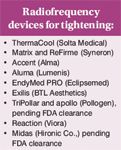- General Dermatology
- Eczema
- Chronic Hand Eczema
- Alopecia
- Aesthetics
- Vitiligo
- COVID-19
- Actinic Keratosis
- Precision Medicine and Biologics
- Rare Disease
- Wound Care
- Rosacea
- Psoriasis
- Psoriatic Arthritis
- Atopic Dermatitis
- Melasma
- NP and PA
- Skin Cancer
- Hidradenitis Suppurativa
- Drug Watch
- Pigmentary Disorders
- Acne
- Pediatric Dermatology
- Practice Management
- Prurigo Nodularis
Article
Radiofrequency successful for aesthetic indications as technology evolves
Radiofrequency has become the newest member of the aesthetic device market. Since its introduction in 2000, numerous devices have been approved by the Food and Drug Administration for indications from wrinkles to fat removal. The data on radiofrequency (RF) and its physiologic actions on the cutaneous system are just now allowing us to better examine what we can clinically accomplish using these devices.

Key Points

The data on radiofrequency (RF) and its physiologic actions on the cutaneous system are just now allowing us to better examine what we can clinically accomplish using these devices. RF treatments have been used in other areas of medicine for adjuvant treatment of tumors, gastrointestinal sphincter tightening, endovascular venous closure, cardiac ablation, upper airway obstruction and as a treatment for nerve pain.
RF revealed
Blood has high electrical conductivity, resulting in more heat in vascular tissues, but also more rapid dissipation of heat. Warmer tissue also has lower tissue impedance, making it easier to heat warm target tissue. Conversely, cooling of tissue results in less electrical conductivity (Horsman MR. Int J Hyperthermia. 2006;22(3):197-203). These properties are used to protect areas via cooling pads, plates or gels while treating other areas with radiofrequency. Target temperatures are needed in the skin to create the collagen production and tightening effects.
Radiofrequency current can be applied to the skin in various manners. Unipolar or monopolar devices have a single electrode that is placed on the treatment area. A grounding pad is placed in an area distant from the treatment area, generally on the back of the patient. The depth of penetration of monopolar radiofrequency depends on the impedance of the tissue and on the size of the electrode. Depth of penetration of monopolar systems can easily reach the subcutaneous fat at some settings.
Bipolar devices consist of two electrodes placed over the treatment area. The depth of penetration of the radiofrequency is based on the tissue impedance and the distance between the two electrodes. The further the distance between the electrodes, the deeper the penetration. Bipolar RF is more superficial than monopolar RF. Clearly, for effective treatment of fat, deeper penetration of heat is needed. Hence, a monopolar system would be more efficacious. However, it is still not clear what depth is required for tissue tightening and collagen production.
Relevant research
Research with RF has clearly demonstrated the ability to introduce heat non-selectively through the skin. Studies in guinea pigs treated with RF demonstrated an increase in dermal thickness, collagen, elastic fibers and mucopolysaccharides (Alvarez N, Ortiz L, Vicente V, et al. Lasers Surg Med. 2008;40(2):76-82). Collagen shrinkage has been seen at temperatures ranging from 60 to 80 degrees Celsius in tissues other than skin. How this translates to collagen tightening in the skin is still not clarified. Epidermal burning can occur at temperatures far lower (43 to 45 degrees C) than those for collagen contraction, so protection of the upper skin layers is important in these treatments.






